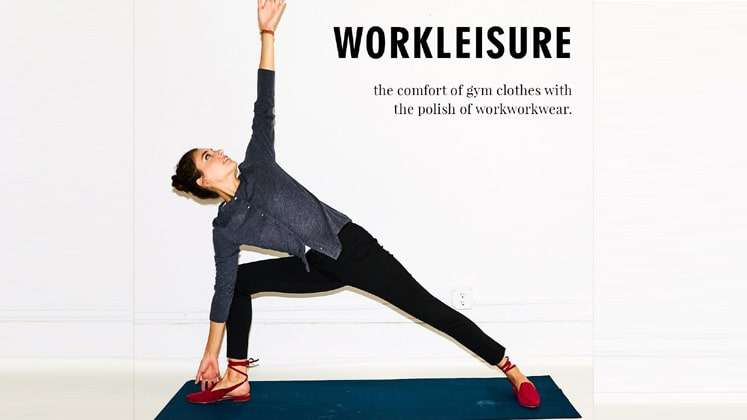
As Americans prepare for their return to the offices, business formals have taken a hit by dipping down on the preference scale. More working professionals envision themselves in comfortable wardrobe choices, instead of the crisp silhouettes for business suits.
Retailers such as Lululemon and Athleta reap profits as the consumer demands gradually shift towards increasingly athletic pieces in their back-to-work wardrobes. The coined term – workleisure – refers to more sophisticated versions of athletic apparel which were until now sported at gym and grocery runs. Bottoms have stretched wider with highly accommodating elastic waistbands. Topwear is not tucked in anymore, and ties have become an optional accessory. Gravitation has been observed in skirts and dresses with relaxed silhouettes over form-fitting trousers. Sneakers, a symbolic representation of comfort footwear, are being preferred over heels, bringing the spotlight on casualwear in the wardrobes.
As per a survey conducted by Cotton Incorporated earlier this year, the number of customers primarily shopping for comfort increased from 63 per cent in 2020 to 74 per cent in 2021. Stitch Fix also reported that searches for comfortable but ‘office-appropriate’ clothing were up by 60 per cent, whereas leggings and loungewear dipped to a corresponding 60 per cent.
Also Read : Shift in mindset: Customers eye value over discounts
Brands such as Nordstrom and Levi Strauss have pivoted as quickly as possible to accommodate more casual apparel in their fall collections. In a market research on clothing categories, Euromonitor predicts the growth of business suits by about 8 per cent over last year. Whereas, categories such as polo-necks and tunics are expected to grow by almost twice the margin.
Adidas, the classic sportwear brand, has also joined the branching movement. The company announced a global expansion into underwear and lingerie in July 2021. These articles, unlike active undergarments such as sports bras essentially sold by Adidas, are traditional underwear made from cotton for everyday use.

DTC activewear brand Rhone placed an emphasis on its ‘commuter’ line, which includes products like chinos and button-down shirts made with the performance material used for loungewear. The brand also observed a 31 per cent hike in sales of its commuter line, since the vaccination drives have begun. Lifestyle products have escalated to make up 60 per cent of the brand’s sales, outrunning the activewear section.
Erin Schmidt at Coresight Research discusses how these numbers highlight the diminished definition of workwear, and its reinvention by the consumer market. With the ever-rising demand for new styles and sizes, apparel sales have been in a consistent ascent. Sale shares for formalwear in the US apparel market have dropped to 24.8 per cent in 2020 from 31.5 per cent in 2019, whereas casualwear sales have ricocheted in the market. Coresight and Euromonitor expect the casualwear sector to dominate the total apparel expenditure for the remainder of 2021 and into 2022.
The convergence of athletic and everyday clothing is happening simultaneously. While activewear brands are deviating towards office-ready styles, traditional fashion brands are launching activewear and casualwear lines. Many retailers such as Beau Ties of Vermont , Brooks Brothers and Banana Republic have pivoted their manufacturing expertise to make up for lost sales amidst the changing consumer demands, by introducing face masks and debuting their first sportwear and casualwear collections, respectively.

However, with the line of distinction getting blurrier between loungewear and workwear, confusion and uncertainty is being observed as people prepare themselves to return to their offices. Nordstrom reports a 165 per cent increase in customer searches for ‘work clothes’ on its e-commerce platform. The retailer also conducted a survey with 2000 people in the US, to explore how the pandemic affected their purchase choices as the post-pandemic life gradually resumes. While 45 per cent of consumers admitted to struggling while finding clothes for their body type, almost 43 per cent struggled to find clothes that fit.
NDP Group resonates with these statistics, as nearly 40 per cent of women are now wearing different clothing sizes compared to a year ago. Nordstrom’s research highlights the need for customers to seek styling guidance for occasion dressing while coming out of the pandemic.
This presents the retail sector with the opportunities to not only provide customers with new fashion, but also provide curated looks for them. Retailers in the denim category are already experiencing the shift due to the sense of experimentation. Levi’s and American Eagle have reported a rise in demand for looser fits.
M.M.LaFleur is taking into account a working environment where employees switch between their time at home and the office. The brand has launched a ‘guide to hybrid dressing’ on their website, providing their customers with outfit ensembles for the complete week. With fluctuating Covid cases and emerging variants, the possibility of delayed return plans has come into sight. Therefore, it is imperative to understand that people now seek comfort in their work environments, and would not shift to any less comfortable situations. This trend, thereby, shall also present itself in their purchase behaviour and demands.

Post a Comment